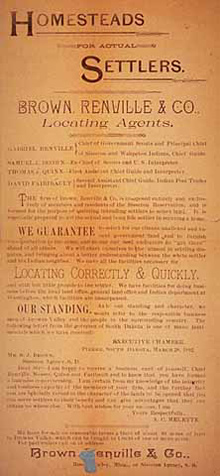Land Speculation, Town Site Development, and Newspapers

Selling Ceded Land
Settlers and pioneers never bought land directly from American Indian nations – that practice was outlawed in the earliest days of the United States. Instead, land was transferred from American Indian peoples to the U.S. federal government, which then distributed it for free or at low prices - often to corporations with political connections. As Ojibwe and Dakota land became available for white settlement in what is now Minnesota, business interests used political connections to acquire as much land as possible. In 1862, the Homestead Act established a new system whereby individual settlers could claim a farm and, after living on it for five years, receive a title to it. But more commonly land was purchased by settlers from corporations, many of which were directly involved in treaty negotiations.
Corporations had many ways to acquire land that had been acquired by the U.S. from Dakota and Ojibwe people. Fur trade companies collapsed used the funds the debt payments they secured through treaties to purchase choice land for resale to settlers. Railroads were given vast tracts of land by the federal government; establishing town sites along the rails generated enough income in land sales to build the rails and make fortunes for railroad company partners. Minnesota's political leaders formed land speculation companies to secure land titles from the government, and from failed homesteaders. And bureaucrats manipulated annuity payments and land assignments established in treaties to secure reservation land for themselves. These speculators then formed townsites throughout the State, and divided the land into lots.
Land speculation exploded in the 1850's, when Dakota and Ojibwe began ceding enormous tracts of land to the U.S. government. The success of these speculative ventures depended on finding people of European descent who were willing to buy the land. This was not as simple as it might seem. The U.S. population was booming in the 1800s, but the U.S. was acquiring Indian land so quickly that regional competition for settlers was intense, Also, recently-ceded areas had no infrastructure that white settlers could recognize;. Speculators in Minnesota as elsewhere created “emigration societies” to market land in the Eastern U.S. and in Europe; the presence of Germans and Scandinavians in Minnesota was a response to these marketing efforts. Newspapers played an important role in “selling” the State to settlers.
The land speculator and the newspaper editor, often one and the same individual, utilized every opportunity to spread information about its [Minnesota’s] unrivaled advantages among the uninformed.Official Encouragement of Immigration to Minnesota During the Territorial Period
J. H. Stevens, on James M. Goodhue, editor of Minnesota Pioneer:
His main object in his editorials was the advertising of the territory, that people who were looking westward might be induced to locate here.
Examples of land speculators who were involved in treaty making include the following:
- Immediately after the Dakota sold millions of acres to the US in 1851, American Fur Company owner Henry Sibley on behalf of Pierre Chouteau Company, bought land near the new Dakota reservation at Traverse des Sioux.
- Indian agent Clark W. Thompson acquired 9,000 acres in 1869 for $1.25 per acre; twenty five years later, he was selling it for $80 per acre.
- Joseph Renshaw Brown, his brother N. R. Brown and James W. Lynde (see also mining and transportation) were partners in the Dakota Land Company, one of the most prominent land speculation ventures in Minnesota. Stillwater and Henderson are among the towns founded by Joseph Brown, who was also involved in the Northwest Pioneer Land Company.
- Alexander and Justin Ramsey acquired a hotel in St. Paul for $2,500 in 1849 that was worth $500,000 40 years later.
- D. G. Morrison owned land near Lake Superior and was one of the founders of Fond du Lac (part of present-day Duluth).
- All of the partners in railroad companies (see Transportation) were in effect involved in land speculation.
- The earliest newspapers in Minnesota were owned by treaty signers Joseph Renshaw Brown, Nathaniel McLean, David Olmstead, and Reuben Ottman. Hercules Dousman created "emigration societies" to market land throughout the Upper Mississippi region, and Martin McLeod promoted immigration to Minnesota from Canada.












